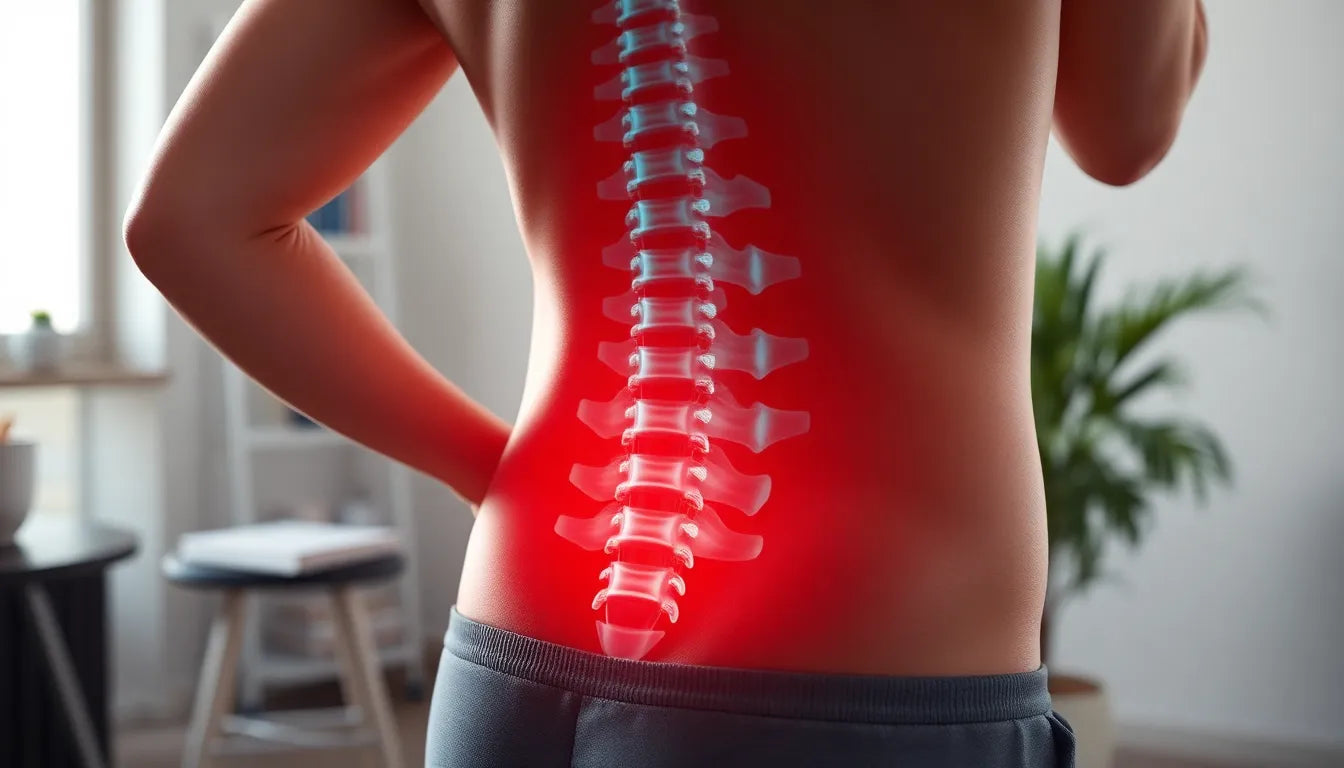Understanding the journey to recovery from a herniated disc begins with grasping the nature of the condition itself. A herniated disc occurs when the soft, gel-like center of a spinal disc pushes through a crack in the tougher exterior casing. This can lead to irritation of nearby nerves, resulting in pain, numbness, or weakness in an arm or leg. The spine, a critical structure in the body, relies on discs to provide cushioning and flexibility. When a disc herniates, it disrupts this balance, often leading to discomfort and mobility issues.
common causes and symptoms of a herniated disc
Herniated discs can be caused by several factors, including age-related wear and tear, known as disc degeneration, or sudden injury. As we age, our spinal discs lose some of their water content, making them less flexible and more prone to tearing or rupturing with even minor strains or twists. Common symptoms include pain that radiates into the arms or legs, numbness or tingling, and muscle weakness. These symptoms can significantly affect daily activities and quality of life, making understanding the recovery process crucial for those affected.
the recovery journey: emotional and physical challenges
Recovering from a herniated disc is often a journey filled with both emotional and physical challenges. The pain and discomfort can be daunting, affecting not only physical health but also mental well-being. It's important to acknowledge that recovery time can vary widely among individuals, influenced by factors such as age, overall health, and the severity of the herniation. While some may experience relief within a few weeks, others might find the journey to be longer and more complex.
Understanding the typical recovery timeline and the factors that influence it can empower patients and their families, providing a roadmap to navigate the ups and downs of recovery. This knowledge is vital, as it helps set realistic expectations and encourages adherence to recommended treatments and lifestyle adjustments. In the following sections, we will delve deeper into the stages of recovery and explore how various factors can impact the healing process, offering valuable insights for anyone on this path to recovery.
typical recovery timeline for a herniated disc
Understanding the typical recovery timeline for a herniated disc is essential for setting realistic expectations and managing the healing process effectively. The journey to recovery can be broadly divided into several phases, each with its unique challenges and milestones.
initial phase (0-2 weeks)
In the initial phase, lasting from zero to two weeks, patients often experience acute symptoms such as severe pain, muscle spasms, and limited mobility. This stage is characterized by intense discomfort as the body begins to respond to the injury. During this time, rest and initial medical care are crucial. Physicians may recommend pain relief medications and anti-inflammatory drugs to manage symptoms, along with gentle rest to prevent further aggravation of the condition.
improvement phase (2-6 weeks)
As patients transition into the improvement phase, typically between two to six weeks, they often notice a gradual reduction in pain and an increase in mobility. This period is marked by the body's natural healing processes taking effect. Physical therapy and gentle exercises become vital components of recovery, helping to strengthen the muscles supporting the spine and improve flexibility. Engaging in these activities under professional guidance can significantly aid in reducing symptoms and enhancing overall function.
significant recovery (6-12 weeks)
Between six to twelve weeks, most patients experience significant improvement in their condition. While pain may continue to decrease, some residual symptoms, such as numbness or tingling, might persist. It is during this stage that many individuals regain much of their normal activity levels, although care must be taken to avoid activities that could exacerbate the condition. Ongoing physical therapy and adherence to recommended exercises play a critical role in ensuring continued progress and preventing recurrence.
long-term healing and factors influencing recovery
While many patients experience relief within the first few months, the full healing of a herniated disc can take considerably longer. The process of disc resorption and tissue healing may extend from five to 22 months, with an average of around 13 months. During this time, most individuals do not experience persistent symptoms, but it is essential to maintain a proactive approach to recovery.
age and overall health
Recovery times can be significantly influenced by a person's age and overall health. Younger individuals and those in good general health often recover more quickly due to better tissue regeneration and healing capabilities. Conversely, older adults or those with underlying health conditions may find that their recovery process is slower and requires more intensive management.
severity of herniation
The severity of the herniation also plays a critical role in determining recovery duration. Mild cases may resolve with conservative treatments, while severe herniations may necessitate longer recovery periods and potentially more invasive interventions. Understanding the extent of the injury can help tailor treatment plans to the individual's needs.
activity level and treatment adherence
Maintaining an appropriate activity level and adhering to prescribed treatments are crucial for optimal recovery. Engaging in regular physical activity, as advised by healthcare professionals, helps strengthen the spine and prevent further injury. Additionally, following medical advice regarding medications, therapy sessions, and lifestyle adjustments is essential for a successful recovery.
role of ergonomic aids
Ergonomic aids, such as those offered by Anodyne, can provide valuable support during the recovery process. These tools help maintain proper posture, reduce strain on the spine, and prevent future injuries. Incorporating ergonomic solutions into daily routines can enhance comfort and facilitate a smoother recovery journey.
In summary, recovering from a herniated disc is a multifaceted process influenced by various factors. By understanding the typical recovery timeline and the elements that affect healing, individuals can better navigate their journey to recovery, making informed decisions that promote long-term spinal health.
Chronic cases and hope for recovery
For individuals experiencing chronic symptoms from a herniated disc, hope remains a crucial component of the recovery journey. Even if symptoms persist beyond the typical recovery timeline, significant improvement is still possible with the right management strategies. Chronic cases, although challenging, can be addressed through a combination of personalized treatment plans, lifestyle adjustments, and ongoing support.
In chronic situations, it is essential to maintain a positive outlook and remain committed to recovery. Engaging in regular physical therapy, utilizing ergonomic aids, and adhering to medical advice can facilitate healing even after prolonged periods. The body's natural ability to adapt and heal should not be underestimated, and with perseverance, many individuals find relief and regain their quality of life.
Visualizing recovery stages
Understanding the stages of recovery can provide a clear roadmap for those on the path to healing from a herniated disc. The journey typically includes the following phases:
| Stage | Description |
|---|---|
| Initial Phase (0-2 Weeks) | Severe pain and muscle spasms, requiring rest and initial medical care. |
| Improvement Phase (2-6 Weeks) | Gradual pain reduction with increased mobility; introduction of physical therapy. |
| Significant Recovery (6-12 Weeks) | Most patients experience substantial improvement; some symptoms may linger. |
| Long-Term Healing (Beyond 12 Weeks) | Continued recovery with potential for occasional flare-ups; focus on maintenance and prevention. |
Frequently Asked Questions
How long does it take for a herniated disc to heal completely?
The recovery time for a herniated disc varies, with most individuals experiencing pain relief within 2 to 12 weeks. However, full disc healing can take 5 to 22 months, depending on factors such as age, health, and the severity of the herniation.
Can a herniated disc heal on its own?
Yes, many herniated discs heal naturally over time as the body absorbs the displaced disc material. While some cases resolve without medical intervention, others may require treatments like physical therapy to aid recovery.
Is surgery always required for a herniated disc?
Surgery is not always necessary for a herniated disc. Most cases improve with non-surgical treatments such as physical therapy, medication, and lifestyle changes. Surgery is typically considered only when conservative treatments fail to alleviate symptoms.
What activities should be avoided during recovery?
During recovery, it is advisable to avoid activities that strain the spine, such as heavy lifting, bending, and twisting. Adhering to recommended exercises and ergonomic practices can prevent exacerbation of symptoms.
Can lifestyle changes aid in faster recovery?
Yes, maintaining a healthy lifestyle can significantly aid recovery. Regular exercise, proper posture, and ergonomic aids can enhance healing and reduce the risk of future injuries. A balanced diet and adequate hydration also support overall health and recovery.
Sources
- HealthCentral (2022-10-18). "Herniated Disc Healing: Timeline and Signs of Improvement."
- CrushBackPain.com. "Herniated Disc Recovery Time...How Long Does it Take?"
- MoreGoodDays.com (2024-12-02). "Discovering Hope: Can a Herniated Disc Heal After 2 Years?"
- Spine MD (2024-04-01). "Signs a Herniated Disc is Healing: Timeline & Recovery."
- Illinois Pain Institute (2024-09-06). "How Long Does a Herniated Disc Take to Heal."
- Mayfield Clinic. "Herniated Lumbar Disc, ruptured disc, bulging disc."























